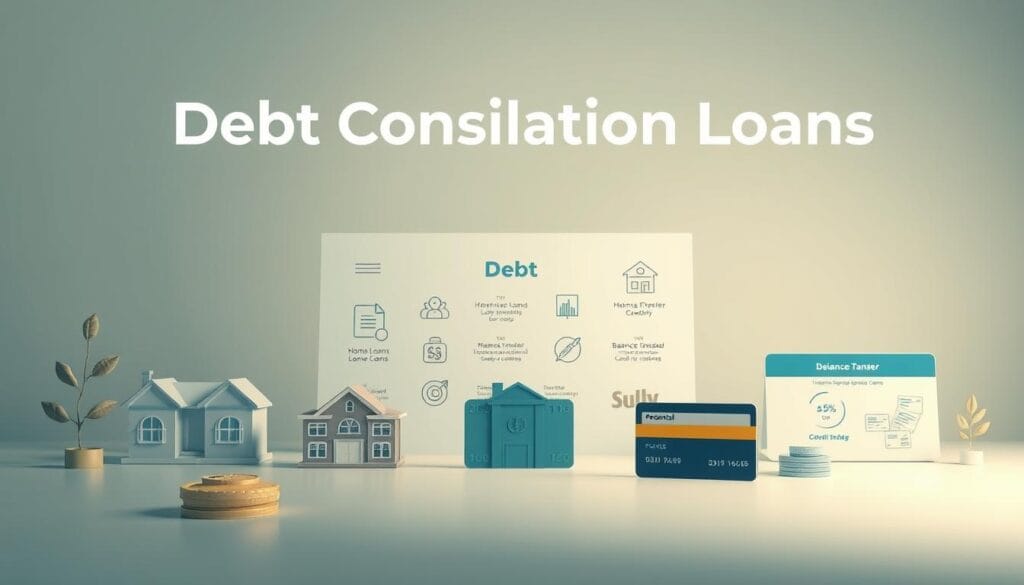Did you know that some lenders can fund a personal loan in as little as 22 hours? LendingClub Bank, for instance, has streamlined its process to ensure 57% of applicants receive funds within 24 hours. This speed is just one of the many advancements shaping the financial landscape in 2025.
As the new year approaches, lenders are introducing innovative features to meet diverse needs. SoFi, for example, offers loans up to $100,000 with interest rates ranging from 8.99% to 29.99% APR. Meanwhile, Upgrade simplifies repayment by sending funds directly to creditors, making it easier to manage multiple balances.
Technology is also playing a bigger role. Upstart uses AI to evaluate applicants based on education and employment history, while Avant caters to those with a credit score as low as 580. These advancements ensure faster approvals and more flexible terms, making 2025 an exciting time for borrowers.
Key Takeaways
- LendingClub Bank funds 57% of loans within 24 hours.
- SoFi offers loans up to $100,000 with competitive rates.
- Upgrade sends payments directly to creditors for convenience.
- Upstart uses AI to assess education and employment history.
- Avant provides options for borrowers with fair credit scores.
For more insights on managing your finances, check out our guide on low-fee robo-advisors for 2025.
What Are Debt Consolidation Loans?

Combining various financial responsibilities into one payment can simplify your life. Debt consolidation loans are unsecured personal loans designed to merge multiple debts into a single, manageable payment. This approach can help reduce stress and streamline your finances.
Understanding the Basics
These loans are often compared to balance transfer credit cards or home equity alternatives. Unlike balance transfers, which typically involve high fees, debt consolidation loans offer fixed interest rates and predictable repayment terms. Home equity options, on the other hand, require collateral, making them riskier.
Before applying, lenders may perform a soft credit check to pre-qualify you. This check is visible only to the applicant and doesn’t affect your credit score. However, a hard credit pull is conducted during the formal application process, which can impact your score.
How Debt Consolidation Works
Once approved, the lender may distribute the loan amount directly to your creditors or provide a lump sum for you to manage. For example, a $19,389 loan from LendingClub at 11.75% interest with a 6% origination fee results in an APR of 16.10%. After fees, the net amount reduces to $18,226.
Typical loan amounts range from $1,000 to $100,000, with repayment terms spanning 24 to 84 months. This flexibility allows borrowers to choose a plan that fits their budget. Additionally, bank-issued consolidation loans are often covered by FDIC insurance, providing an extra layer of security.
Benefits of Debt Consolidation Loans

Managing multiple financial obligations can feel overwhelming, but there’s a solution. Combining payments into one can offer significant advantages, from saving money to improving your financial health. Let’s explore the key benefits.
Lower Interest Rates
One of the most compelling reasons to combine payments is the potential for lower interest rates. Credit cards often carry an average APR of 24.7%, while combined payment options can start as low as 7.99%. For example, a $15,000 balance at 24% interest costs significantly more than the same amount at 12%.
Lenders like SoFi offer additional discounts, such as a 0.25% reduction for autopay, further lowering your effective rate. These savings can add up over time, making it easier to pay off your balance faster.
Simplified Monthly Payments
Keeping track of multiple due dates and amounts can be stressful. Combining payments into one simplifies your financial life. Instead of managing several bills, you’ll have a single payment to focus on.
This approach also reduces the risk of missed payments, which can hurt your credit score. With one payment, it’s easier to stay organized and avoid late fees.
Improved Credit Score
Combining payments can positively impact your credit score in two ways. First, it lowers your credit utilization, which is a key factor in credit scoring models. Staying below the 30% threshold is ideal.
Second, consistent, on-time payments build a positive payment history. Lenders like Upgrade report to all three credit bureaus, helping you strengthen your credit profile over time.
While a hard inquiry during the application process may cause a temporary dip of 2-5 points, the long-term benefits far outweigh this minor setback.
For more tips on managing your finances, check out our guide on paying off balances faster.
Types of Debt Consolidation Loans

Understanding the different options available can help you make an informed decision. Whether you’re looking to simplify payments or reduce interest rates, there are several ways to achieve your financial goals.
Personal Loans
Personal loans are a popular choice for many borrowers. These loans are unsecured, meaning they don’t require collateral like a home or car. They typically offer fixed interest rates and repayment terms ranging from 2 to 7 years1. Borrowers with higher credit scores often secure lower rates, making this option cost-effective for those with good credit.
Some lenders, like Upstart, offer loans up to $50,000, while others, such as SoFi, extend up to $100,000. It’s important to compare offers, as origination fees can range from 1% to 10% of the loan amount1.
Home Equity Loans
Home equity loans allow homeowners to borrow against the equity in their property. These loans often come with lower interest rates compared to unsecured options, as they are secured by the home1. However, this also means the borrower risks losing their property if they default.
Repayment terms for home equity loans typically range from 10 to 20 years. Interest rates can be variable, so it’s crucial to understand the terms before committing1.
Balance Transfer Credit Cards
For those with credit card debt, balance transfer credit cards can be a useful tool. These cards offer an introductory period with 0% APR, usually lasting 12 to 21 months1. This allows borrowers to pay off their debt without accruing interest, provided the balance is cleared within the promotional period.
However, balance transfer fees typically range from 3% to 5% of the transferred amount. After the introductory period, the interest rate reverts to a higher variable rate, so careful planning is essential1.
Niche options, like credit union loans, can also be beneficial. For example, PenFed offers personal loans with rates starting as low as 5.99% APR2. Secured loans, backed by assets like vehicles or savings accounts, may offer lower rates but come with the risk of losing the collateral3.
Upstart’s education-based underwriting model provides a unique approach, considering factors like education and job history alongside traditional credit metrics4. This can be particularly helpful for those with limited credit history.
Eligibility Criteria for Debt Consolidation Loans

Securing financial stability often starts with meeting specific criteria set by lenders. Understanding these requirements can help you prepare and improve your chances of approval. Let’s break down the key factors lenders evaluate.
Credit Score Requirements
Your credit score plays a significant role in determining eligibility. Lenders typically categorize scores into tiers: Excellent (720+), Good (680-719), and Fair (580-679). For example, SoFi requires a minimum score of 680, while Avant accepts applicants with scores as low as 580.
Higher scores often lead to better interest rates and terms. If your score falls below the required threshold, consider improving it before applying or exploring lenders with more flexible requirements.
Income and Employment Verification
Lenders need proof of stable income to ensure you can repay the loan. Common documents include pay stubs, W-2s, and tax returns for self-employed individuals. Some lenders may also verify employment directly with your employer.
Having a steady income stream increases your chances of approval. If your income fluctuates, gather additional documentation to demonstrate financial stability.
Debt-to-Income Ratio
Your debt-to-income ratio (DTI) is another critical factor. It’s calculated by dividing your monthly debts by your gross income. Most lenders prefer a DTI below 43%, though some, like SoFi, allow up to 45%.
If your DTI is high, consider paying down existing balances or increasing your income to meet lender thresholds.
Additional qualifications, such as cosigners, collateral, or a strong banking history, can also improve your chances. Be aware of geographic restrictions, as some lenders, like LendingPoint, are unavailable in certain states. Programs like SoFi’s unemployment protection add an extra layer of security for borrowers.
How to Choose the Best Debt Consolidation Loan

Selecting the right financial solution requires careful consideration of multiple factors. From interest rates to repayment terms, each element plays a crucial role in determining the overall cost and convenience. Here’s a detailed guide to help you make an informed decision.
Comparing Interest Rates
One of the most critical factors is the interest rate. This determines how much you’ll pay over the life of the agreement. For example, a fixed rate remains constant, while a variable rate can fluctuate with market conditions. Lenders like SoFi offer competitive rates starting as low as 7.99% APR, making them a popular choice for borrowers with excellent credit.
To calculate the total cost, consider the APR, which includes both the interest rate and any additional fees. For instance, a $10,000 agreement with a 10% interest rate and a 2% origination fee results in an APR of 12%. Use an amortization calculator to compare offers and understand the long-term impact.
Evaluating Loan Terms
The length of the agreement, or loan terms, affects both your monthly payments and the total interest paid. Shorter terms typically have higher monthly payments but lower overall costs. Conversely, longer terms reduce monthly payments but increase the total interest.
For example, a $15,000 agreement with a 5-year term at 8% APR results in lower monthly payments but higher total interest compared to a 3-year term. Choose a term that aligns with your budget and financial goals.
Considering Fees and Penalties
Hidden costs can significantly impact the affordability of your agreement. Common fees include origination fees, late payment penalties, and check processing fees. LendingClub, for instance, charges origination fees ranging from 0% to 8%.
Additionally, some agreements include prepayment penalties, which can be as high as 5% in certain states. Always review the fine print and negotiate fees whenever possible. Studies show that 76% of borrowers with good credit successfully negotiate lower fees.
By carefully comparing these factors, you can choose a solution that meets your needs and helps you achieve financial stability.
Top Debt Consolidation Loans for 2025

Navigating the financial landscape in 2025 offers a variety of options to streamline your payments. From competitive rates to innovative features, these providers stand out for their unique offerings. Here’s a detailed comparison to help you choose the best fit for your needs.
LendingClub Bank
LendingClub Bank partners with credit unions to offer loan amounts ranging from $1,000 to $40,000, with APRs between 7.90% and 35.99%5. This model allows borrowers to access competitive rates while benefiting from the infrastructure of credit unions. Funding is available as soon as the next business day, making it a convenient choice for urgent needs.
SoFi
SoFi provides loan amounts from $5,000 to $100,000, with APRs starting at 8.99%5. Beyond financial solutions, SoFi offers member benefits like career coaching and financial planning services. These resources are designed to help members achieve their professional and financial goals.
Upstart
Upstart uses an AI-driven underwriting model that considers factors like education and employment history. This approach allows borrowers with a credit score as low as 620 to qualify for loans5. APRs range from 6.7% to 36%, and funding can be completed as soon as the next business day.
LendingPoint
LendingPoint offers next-day funding for borrowers with a FICO score of 680 or higher. APRs range from 9.99% to 35.99%, and origination fees are between 0% and 6%5. This provider is ideal for those with fair credit who need quick access to funds.
Upgrade
Upgrade simplifies repayment by sending funds directly to creditors. Terms are flexible, with APRs ranging from 7.99% to 35.99%5. Borrowers can also benefit from autopay discounts, making it easier to manage payments and save on interest.
Avant
Avant caters to borrowers with a credit score as low as 550, offering loans starting at $2,000. APRs range from 9.95% to 35.99%, and funding is available as soon as the next business day5. This provider is a great option for those looking to rebuild their credit.
By comparing these options, you can find a solution that aligns with your financial goals and needs. Whether you prioritize speed, flexibility, or additional benefits, these providers offer a range of features to simplify your financial management.
LendingClub Bank: Best for Fast Funding

Speed and efficiency are key when securing financial solutions, and LendingClub Bank excels in this area. With an average approval time of 22 hours in Q4 2024, it’s no surprise that 57% of applicants receive funds within 24 hours. This makes LendingClub Bank a top choice for those who need quick access to funds.
Loan Terms and Rates
LendingClub Bank offers loan terms ranging from $1,000 to $40,000, with APRs between 7.90% and 35.99%. Origination fees vary from 0% to 8%, depending on the borrower’s credit profile. For example, a $19,389 loan with an 11.75% interest rate and a 6% origination fee results in an APR of 16.10%.
State-specific variations apply, such as a $10,000 minimum in California. Borrowers should also note that some loans require credit union membership, which may involve additional steps.
Pros and Cons
LendingClub Bank’s primary advantage is its speed. It outpaces 78% of competitors, according to NerdWallet. However, potential delays can occur due to investor commitments, which may slow down the funding process in rare cases.
On the downside, the origination fee can be a significant cost. For instance, a $19,389 loan with a 6% fee results in a $1,163 charge. Borrowers should carefully evaluate the total cost before proceeding.
Despite these considerations, LendingClub Bank remains a reliable option for those prioritizing fast funding and flexible loan terms.
SoFi: Best for Excellent Credit

For borrowers with strong financial profiles, SoFi stands out as a top choice. It offers loan amounts ranging from $5,000 to $100,000, with APRs starting at 8.99%. This flexibility makes it ideal for those seeking larger sums or extended repayment terms.
Loan Terms and Rates
SoFi’s repayment terms span from 24 to 84 months, providing borrowers with customizable options. Unlike many competitors, SoFi charges no origination fees, making it a cost-effective choice. Additionally, borrowers can enjoy discounts of 0.25% for autopay and another 0.25% for direct deposit, further reducing their effective APR.
Pros and Cons
SoFi’s exclusive benefits set it apart. Beyond financial solutions, it offers career coaching and financial planning services. Its unemployment protection program allows payment deferral and job search assistance, providing peace of mind during uncertain times.
However, SoFi’s steep credit requirements may be a barrier for some. A minimum FICO score of 680 is typically required, making it less accessible to those with fair or poor credit. For those who qualify, SoFi’s jumbo loan amounts and competitive APRs make it a standout option.
For more insights on managing your finances, explore our guide on decentralized lending benefits.
Upstart: Best for All Credit Score Types

Upstart revolutionizes the lending landscape by catering to all credit score types, making financial solutions accessible to a broader audience. Its AI-driven underwriting model analyzes 1,648 data points, including education and employment history, to assess eligibility. This approach ensures a 27% higher approval rate compared to traditional models, making it a standout choice for diverse borrowers.
Loan Terms and Rates
Upstart offers loan amounts ranging from $1,000 to $50,000, with APRs between 7.80% and 35.99%. Its fee structure varies by state, with origination fees ranging from 0% to 12%. While most loans are unsecured, Upstart occasionally offers vehicle-secured options for niche cases.
Pros and Cons
One of Upstart’s key advantages is its inclusivity. It considers non-credit factors like work experience and education, making it ideal for recent graduates and new immigrants. However, subprime borrowers may face higher APRs, which can increase the overall cost.
For those seeking the best financial solutions for all credit, Upstart’s innovative approach and flexible terms make it a top contender.
LendingPoint: Best for Fair Credit

LendingPoint offers a tailored approach for borrowers with fair credit, making it a standout choice for those seeking financial flexibility. With APRs ranging from 7.99% to 35.99%, it caters to individuals with FICO scores as low as 600, providing a sweet spot for those in the 600-679 range.
Loan Terms and Rates
LendingPoint provides loan terms from $2,000 to $30,000, with next-day funding available for qualified applicants. The mobile app features payment tracking and balance updates, ensuring borrowers stay on top of their finances.
An autopay discount of 0.25% is available, helping borrowers reduce their effective APR. However, it’s important to note that the highest-risk borrowers may face APRs up to 35.99%.
Pros and Cons
One of LendingPoint’s key advantages is its focus on fair credit, offering lower minimums compared to competitors like Avant. However, geographic restrictions apply, as it is unavailable in Nevada and West Virginia.
While the fees are competitive, the high APRs for higher-risk borrowers can be a drawback. For more details, review our terms and conditions.
Upgrade: Best for Paying Lenders Directly

Streamlining financial responsibilities is easier with Upgrade’s direct payment system. This feature simplifies the process by sending funds directly to creditors, ensuring timely and hassle-free payments.
Loan Terms and Rates
Upgrade offers loan terms ranging from $1,000 to $50,000, with APRs between 7.99% and 35.99%. Its automated debt payoff system covers 87% of creditors, making it a convenient choice for borrowers.
Checking account integration is another standout feature. Borrowers can link their accounts for autopay, earning a 0.50% rate discount for direct debt payoff. However, origination fees of 1.85% to 9.99% are deducted upfront, which can impact the net loan amount.
Pros and Cons
Upgrade’s direct payment system is a major advantage, reducing the risk of missed payments and improving financial management. The autopay discount further enhances its appeal, making it a cost-effective option.
On the downside, the origination fees can be a significant expense. Additionally, loan terms are limited to 24-84 months, which may not suit all borrowers. Compared to Payoff, Upgrade offers higher loan amounts, making it a better choice for those needing larger sums.
For more insights on financial management, explore our guide on AI in credit risk assessment.
Avant: Best for Fair Credit

Avant provides a streamlined solution for borrowers with fair credit, offering flexibility and accessibility. With APRs ranging from 9.95% to 35.95%, it caters to individuals with a credit score as low as 580. This makes it an ideal choice for those seeking quick funding without stringent credit requirements.
Loan Terms and Rates
Avant offers loan amounts from $2,000 to $35,000, with next-day funding available for qualified applicants. Its mobile-first platform boasts a 92% application completion rate, ensuring a seamless user experience. Borrowers can also take advantage of a soft credit check during prequalification, which doesn’t impact their credit score.
However, administrative fees can vary by state, ranging up to 9.99%. While the APR ceiling of 35.95% may be a concern for some, Avant’s competitive terms and accessibility make it a standout option for those with fair credit.
Pros and Cons
One of Avant’s key advantages is its focus on borrowers with fair credit, offering lower fees compared to competitors like OneMain. Its mobile-first approach ensures convenience and efficiency, making it a popular choice for tech-savvy users.
On the downside, the high APR ceiling can increase the overall cost for higher-risk borrowers. Additionally, Avant does not allow cosigners, which may limit qualification options for some applicants. Despite these drawbacks, Avant remains a reliable solution for those seeking flexibility and accessibility.
How to Apply for a Debt Consolidation Loan

Applying for financial assistance can seem daunting, but understanding the process makes it manageable. Whether you’re looking to streamline payments or reduce interest rates, knowing the steps involved can help you navigate the application with confidence.
Pre-Qualification Process
Most lenders offer a pre-qualification process, which involves a soft credit check that doesn’t impact your credit score. This step allows you to check rates and terms without committing. According to recent data, 83% of lenders provide this option, making it a convenient starting point.
During pre-qualification, you’ll provide basic information about your income and financial obligations. This helps lenders assess your eligibility and offer preliminary terms. You can compare multiple offers to find the best fit for your needs.
Required Documentation
Once you’ve chosen a lender, the next step is gathering the necessary documentation. Common requirements include a government-issued ID, recent pay stubs, bank statements, and a detailed list of your debts.
Lenders may use tools like Plaid for automated verification or require manual uploads. Ensuring you have all the required documents ready can speed up the application process.
Approval and Funding Timeline
After submitting your application, the approval process typically takes 1 hour to 1 business day. Once approved, funding can be completed in as little as 1 day via ACH or up to 5 days with a check.
It’s important to note that application spikes, especially in December, can lead to longer wait times. Planning ahead can help you avoid delays. For more details on the process, you can explore Wells Fargo’s loan options.
Common Mistakes to Avoid When Consolidating Debt
Simplifying your financial life requires avoiding common pitfalls that can derail your progress. While streamlining payments can be beneficial, certain missteps can lead to more challenges. Understanding these mistakes can help you make smarter decisions.
Taking on New Debt
One of the most significant risks is acquiring new debt after streamlining payments. Studies show that 34% of borrowers take on additional obligations within six months. This can create a snowball effect, with 29% of individuals increasing their credit card usage post-consolidation.
To avoid this, focus on addressing the root causes of financial strain. Creating a budget and sticking to it can help prevent overspending and ensure long-term stability.
Ignoring the Fine Print
Another common mistake is neglecting to read the fine print. Surprisingly, 61% of borrowers don’t review the full terms before signing. Hidden fees, such as prepayment penalties or late fees, can significantly increase costs.
Always take the time to understand the agreement. Look for APR lock guarantees, which only 38% of lenders offer, to secure a stable interest rate.
Not Comparing Multiple Offers
Failing to compare multiple offers can result in missed opportunities for better terms. Lenders vary in their fee structures, interest rates, and repayment flexibility. For example, some exclude certain categories from balance transfers, which can limit your options.
Use tools like the CFPB’s loan estimate worksheet to evaluate 12 key factors, including fees and terms. This ensures you choose the most cost-effective solution for your needs.
By avoiding these mistakes, you can streamline your finances effectively. For more insights, explore our guide on common mistakes to avoid.
Alternatives to Debt Consolidation Loans
Exploring other financial strategies can provide clarity and relief. While traditional methods are effective, alternatives like debt management plans, debt settlement, and bankruptcy offer unique benefits and considerations. Understanding these options can help you choose the best path for your financial health.
Debt Management Plans
A debt management plan (DMP) is a structured repayment program facilitated by credit counseling agencies. These plans typically last 48 months and involve negotiating lower interest rates with creditors. Costs include a setup fee of $0-$50 and monthly fees ranging from $25-$75.
DMPs can positively impact your credit score by ensuring consistent payments. However, they require discipline and may limit access to new credit during the repayment period.
Debt Settlement
Debt settlement involves negotiating with creditors to pay a lump sum that’s less than the total owed. While this can reduce your financial burden, it comes with risks. Settled debts may trigger a 1099-C form, resulting in taxable income.
Statistics show that only 23% of settlement offers are successful. Additionally, this approach can negatively affect your credit score and lead to legal actions from creditors.
Bankruptcy
Bankruptcy is a legal process that provides relief from overwhelming financial obligations. Chapter 7 bankruptcy, which stays on your credit report for 10 years, involves liquidating assets to pay off debts. Chapter 13, on the other hand, allows for a repayment plan over 3-5 years.
While bankruptcy can offer a fresh start, it has long-term consequences, including a significant impact on your credit score and limited access to credit in the future.
When considering these alternatives, it’s crucial to recognize potential scams. Red flags include upfront fees, promises of guaranteed results, and pressure to act immediately. For more insights on managing financial challenges, explore our guide on fast and affordable cross-border payments.
Conclusion
As financial solutions evolve, understanding the latest advancements can help you make informed decisions. In 2025, faster funding and AI-driven underwriting are transforming the landscape, offering borrowers greater flexibility and efficiency.
Top picks like LendingClub Bank excel in speed, while SoFi stands out for its competitive terms. Upstart’s innovative approach caters to all credit score types, making it a versatile choice for diverse borrowers.
Consistent payments not only simplify your finances but also build your credit score over time. However, it’s crucial to avoid overborrowing. Experts recommend maintaining a 15% debt-to-loan ratio to ensure financial stability.
Before committing, compare offers from at least three lenders and consult non-profit counselors for guidance. Use tools to audit fees, compare rates, and plan payments effectively. For more insights, explore options for personal loans to find the best fit for your needs.
FAQ
What is a debt consolidation loan?
How does debt consolidation improve my credit score?
What types of loans can be used for debt consolidation?
What credit score is needed for a debt consolidation loan?
How do I compare debt consolidation loan offers?
Can I get a debt consolidation loan with bad credit?
How long does it take to get approved for a debt consolidation loan?
Are there alternatives to debt consolidation loans?
What mistakes should I avoid when consolidating debt?
How do I apply for a debt consolidation loan?
Source Links
- https://www.nerdwallet.com/article/loans/personal-loans/debt-consolidation-credit-card-balance-transfer
- https://www.penfed.org/personal-loans/personal-loans
- https://www.bankrate.com/loans/personal-loans/secured-vs-unsecured-loans/
- https://www.upstart.com/borrower/education-based-underwriting
- https://www.forbes.com/advisor/personal-loans/upstart-vs-sofi/

